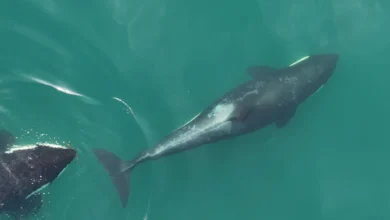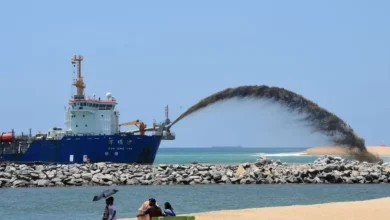Penguins on the precipice: Survival in the ‘noisiest bay in the world’

The first time I visited St Croix island, in 2017, it was home to about 6,000 breeding pairs of African penguins – 35 percent of the global population of this endangered species.
On a blissful September morning, we sped across Algoa Bay on South Africa’s east coast, past a grimy cargo ship and the bulging meringue that is the Nelson Mandela Bay football stadium, before stopping alongside St Croix. The boat rocked from side to side as waves broke against the tiny, jagged outcrop that has wrecked many a ship over the centuries.To the human eye, the rocky, sun-baked pinprick seemed a pretty inhospitable place but birds clearly saw things differently. A waddling throng of knee-high penguins huddled above the high-water mark while, behind them, a lone gull perched on a replica of the cross erected by the Portuguese explorer Bartolomeu Dias in 1488.
The solution is simple, says Pichegru: “Bunkering should not be allowed.” Ships use it to avoid paying port fees and it provides “a cheap refuelling loophole” which deprives the country of tax money and causes untold environmental damage.
The good news is that it is not too late to save the St Croix colony. In October 2023, all three bunkering companies had their licences suspended over tax irregularities. As soon as the bunkering stopped, the penguins started coming back.
In the 2023 breeding season, when bunkering was still in full swing, about 700 breeding pairs used the island. This year, with bunkering on hold, that number has almost doubled to 1,350 breeding pairs.
But the moratorium is only temporary. This February, the South African Maritime Safety Authority (SAMSA) announced that it would be processing new bunkering applications “without delay”.
Bunkering has not resumed yet but the conservation community is already engaging with the government about a legal loophole that allows applications to be “approved without any environmental scrutiny of the risks and impacts associated with bunkering”, says Kate Handley, the executive director of the Biodiversity Law Centre.
The bigger picture
It isn’t just St Croix – overall, African penguins, the continent’s only penguin species, are in a precarious position.
At the turn of the last century, between 1.5 million and 3 million birds roamed the coastlines of Namibia and South Africa. That number has plummeted to 9,900 breeding pairs – a 99 percent decline in 120 years, says Alistair McInnes, who heads up the Seabird Conservation programme at BirdLife South Africa. At the current rate of decline, which is 7.9 percent annually, the African penguin will go extinct in the wild by 2035.
Bunkering is not the only reason for the penguins’ peril – but it is arguably the easiest to address.
From the 1840s onwards, guano collection for the fertiliser industry had a devastating impact on seabird colonies the world over. Dyer Island, on South Africa’s east coast, used to be home to more than a million African penguins who nested in the 4-6 metre (13.19 ft) layer of guano that coated the island. Now the guano is gone and just 2,040 pairs used the island in the 2023 breeding season.
What’s more, between 1920 and 1950, a taste for penguin eggs (they were served on the Titanic and in South Africa’s parliament) saw approximately 48 percent of African penguin eggs being eaten by humans.










